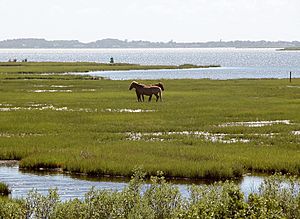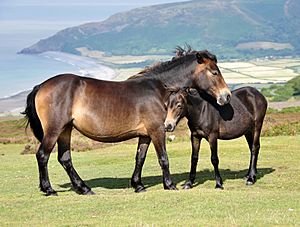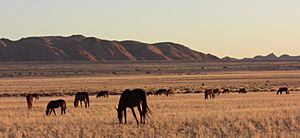Feral horse facts for kids

A feral horse is a horse that lives freely in the wild but originally came from domesticated horses. Think of them as horses that once had human owners but now live on their own. They are not truly "wild" animals like a zebra or a Przewalski's horse, which have never been domesticated. However, many people still call them "wild horses."
Feral horses live in groups, often called a herd or band. These groups are usually small, with a lead mare (female horse), other mares, their young foals, and some younger horses. There's usually one main stallion (male horse) in the group. Sometimes, a few other males might stay with the band. These bands often share a larger area with other horse bands. As young horses grow up, they might leave their birth band to join new ones or form their own. To keep a healthy group of free-roaming horses, especially in smaller areas, you need at least 150 to 200 animals to make sure there's enough variety in their genes.
Contents
Where Do Feral Horses Live?
Horses living in an untamed state, whose ancestors were once domesticated, are known as feral horses. The only truly wild horses left today are the Przewalski's horse from central Asia. A famous example of feral horses are the "wild" horses of the American West. When Europeans brought horses back to the Americas (they had died out there before), some of these horses escaped. Their descendants became the well-known Mustangs.
Feral Horse Populations Around the World
Australia has the largest number of feral horses, with over 400,000 of them! They are called Brumbies, and they are descendants of horses brought by English settlers.
In Portugal, you can find two groups of free-roaming feral horses: the Sorraia in the southern plains and the Garrano in the northern mountains. There are also isolated groups of feral horses in other places. These include Sable Island off Nova Scotia, Assateague Island off Virginia and Maryland, Cumberland Island, Georgia, and Vieques island near Puerto Rico. Some stories say these horses swam to land after shipwrecks. Others might have been left behind by settlers.
More than 400 feral horses live near the Cincar mountain in Bosnia and Herzegovina. These horses came from animals set free in the 1950s. They have been protected since 2010.
In India, a group of about 79 feral horses, called Janghali ghura, lives in the Dibru-Saikhowa National Park. These horses are descendants of animals that escaped army camps during World War II.
In North America, today's feral horses came from horses brought by Europeans. While ancient horses once lived in North America, they are not the same species as modern horses. In the western United States, certain groups of horses and burros are protected by a law called the Wild and Free-Roaming Horses and Burros Act of 1971.
Types of Feral Horses You Might See
Many types of horses live in a feral state, even if some of their relatives are domesticated. Here are some examples:
- Kundudo horse in Ethiopia, which is facing extinction.
- Namib desert horse in Namibia.
- Alberta Mountain Horse or Alberta Wildie in the Rocky Mountains of Alberta, Canada.
- Banker horse on the Outer Banks of North Carolina, United States.
- Chincoteague Pony on Assateague Island off Virginia and Maryland, United States.
- Cumberland Island horse on Cumberland Island off southern Georgia, United States.
- Elegesi Qiyus Wild Horse (Cayuse) in Nemaiah Valley, British Columbia, Canada.
- Mustang in the western United States, protected by law.
- Nokota horse in North Dakota, United States.
- Sable Island horse on Sable Island, Nova Scotia, Canada.
- Lavradeiros in Northern Brazil.
- Small wild horses in the Sierra Nevada de Santa Marta in Colombia, thought to be from horses brought by Spanish conquistadors.
- Misaki horse in Cape Toi, Japan.
- Delft Island horse on Neduntheevu or Delft Island, Sri Lanka. These horses are believed to be descendants of horses kept there during Dutch rule.
- Danube Delta horse in and around Letea Forest, Romania.
- Garrano, a feral horse from northern Portugal.
- Giara horse in Sardinia.
- Marismeño in the Doñana National Park in Huelva, Spain.
- Welsh Pony, mostly domesticated, but about 180 animals roam the Carneddau hills of North Wales. Other groups live in the eastern Brecon Beacons National Park.
- Brumby in Australia.
- Kaimanawa horse in New Zealand.
- Marquesas Islands horse on Ua Huka, Marquesas Islands, French Polynesia.
What Are Semi-Feral Horses?

Some groups of free-roaming horses and ponies live in places like the United Kingdom (such as Dartmoor, Exmoor, and the New Forest). They look wild, but they are not truly feral. These animals are actually owned by people and graze on common lands. Some of them might even be trained but are just let out to live freely for a while, perhaps to grow stronger or to have foals. In other cases, governments might own and manage these animals on special reserves.
Here are some examples of semi-feral horses:
- Camargue horse in the marshes of the Rhone delta, southern France.
- Dartmoor pony, England; mostly domesticated, but also lives in semi-feral herds.
- Exmoor pony, England; mostly domesticated, but also lives in semi-feral herds.
- Fell pony, mostly domesticated, but also lives in semi-feral herds in northern England, especially Cumbria.
- Gotlandsruss, lives in a semi-feral herd in Lojsta Moor on the Swedish Island of Gotland.
- Konik, mostly domesticated, lives semi-feral in the Oostvaardersplassen in the Netherlands.
- New Forest pony, mostly domesticated, but also lives in semi-feral herds in Hampshire, England.
- Pottok, mostly domesticated, but also lives in semi-feral herds in the western Pyrenees.
- Dülmen pony, a German pony that lives in a wild herd in Westphalia with little human help.
How Feral Horses Affect Their Environment
Feral horse populations can sometimes cause disagreements. People who raise livestock might not agree with horse lovers or those who care about animal welfare. How feral horses impact the environment depends on where they live. If they are in an area where their wild ancestors once lived, and their numbers are controlled, they might not cause much harm. This is especially true if they don't compete with farm animals for food.
However, in places like Australia, where horses are an introduced species (meaning they weren't originally from there), or if there are too many horses for the land to support, they can cause problems. This can include damage to the soil, overgrazing plants, and affecting native animals.
If feral horses live near farms, they might damage fences. In some areas, like the Western United States, feral horses compete with farm animals for grazing land. This leads to arguments about which animals are causing more damage to the land. Some people want to remove the feral horses to make more room for cattle or sheep. Others want fewer farm animals on public lands to help the feral horse populations.
Some feral horse groups are very special because of their history or how people feel about them. Examples include the Chincoteague ponies on Assateague Island, which is a delicate coastal area, or the Misaki pony in Japan. These groups are carefully managed. They often help local economies by attracting tourism. Most stable feral horse populations are managed by controlling their numbers. This might involve capturing extra animals for adoption or sale.
See also
 In Spanish: Caballo cimarrón para niños
In Spanish: Caballo cimarrón para niños



